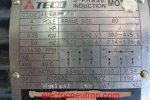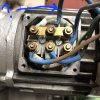You are using an out of date browser. It may not display this or other websites correctly.
You should upgrade or use an alternative browser.
You should upgrade or use an alternative browser.
How To Electrical - star vs delta with 3ph 380V and vfd
- Thread starter HSC ///
- Start date
- Joined
- Jan 21, 2020
- Messages
- 424
Yes. On this side of the pond, things are more simple. Neutral in a 3 phase motor is for security not for power.but over in Europe, you might have 220 on a single leg?
Nathan the Machinist
KnifeMaker / Machinist / Evil Genius
Moderator
Knifemaker / Craftsman / Service Provider
- Joined
- Feb 13, 2007
- Messages
- 15,714
Yes. On this side of the pond, things are more simple. Neutral in a 3 phase motor is for security not for power.
Huh? Can you elaborate a little bit? I don't quite get your meaning.
I’m not certain but my research indicates a live and a neutral so yes 230 on a single legIs your native 220 a 220 hot and a zero voltage neutral? Like our 120 is here in the States. Here in the United States we build 240 across two hot legs, but over in Europe, you might have 220 on a single leg?
Just curious
- Joined
- Jan 21, 2020
- Messages
- 424
You have 110V and 220V as single phase. Your 220V is a combo of 2x 110V. 2 110V Phases and one neutral. Right? We just have 220V single phase. So our "normal" house hold pulls less current. 3 phase is 380V. All 3ph motors use only the 3 phases. Neutral is for protection as grounding of the coils. Neutral in 3ph serves as a step down for 220V when a phase is connected with a neutral. We have 3ph distribution and locally is transferred to 1ph or used also as 3ph per need (some don't use gas for heating, but electricity, and 220V can't pull that much current (limited)).Huh? Can you elaborate a little bit? I don't quite get your meaning.
Yes I agree. This is what I’m seeing as wellView attachment 2004856
I believe the way it is jumpered now is still the correct way when ran with the VFD. Off your VFD you will run phase one two and three to U V and W respectively the ground to the chassis screw.
Above picture just for reference.
By the way, the vfd manufacturer says I don’t need the neutral. What do you think?
DaKruiser
Gold Member
- Joined
- Apr 9, 2011
- Messages
- 513
On the output? No. Input, yes.Yes I agree. This is what I’m seeing as well
By the way, the vfd manufacturer says I don’t need the neutral. What do you think?
Your neutral is the current return path, electricity is a universal language, always the same.
You also want your ground, that’s your safety incase something happens with the neutral.
On the motor I leave the wiring it as is.On the output? No. Input, yes.
Your neutral is the current return path, electricity is a universal language, always the same.
You also want your ground, that’s your safety incase something happens with the neutral.
The 5 wires from the motor I have to connect to the vfd. U V W and ground. So where does the neutral go? Or as the vfd mfg says - I don’t need it?

- Joined
- Jan 21, 2020
- Messages
- 424
No neutral to the motor. All is good.On the motor I leave the wiring it as is.
The 5 wires from the motor I have to connect to the vfd. U V W and ground. So where does the neutral go? Or as the vfd mfg says - I don’t need it?

I posted the label, scroll up to the page 1 posts. ATO.com GK3000-CS0007Can you share the inverter model?
Nathan the Machinist
KnifeMaker / Machinist / Evil Genius
Moderator
Knifemaker / Craftsman / Service Provider
- Joined
- Feb 13, 2007
- Messages
- 15,714
There is some bad information that has been posted in this thread so anybody reading this thread for information should take what they read with a grain of salt.
Nathan the Machinist
KnifeMaker / Machinist / Evil Genius
Moderator
Knifemaker / Craftsman / Service Provider
- Joined
- Feb 13, 2007
- Messages
- 15,714
Generally speaking, most three-phase motors do not use a neutral. However, in the picture shown before, that blue wire attached to the bridge would be neutral, by European wiring convention. Like I said, I'm not sure why that's there, it's surprising to me, but it is possible that this motor might actually use a neutral. If that is a case, be aware that the line to neutral voltage is going to be very different across your three legs if that variable frequency drive is not designed for this kind of application.
Nathan the Machinist
KnifeMaker / Machinist / Evil Genius
Moderator
Knifemaker / Craftsman / Service Provider
- Joined
- Feb 13, 2007
- Messages
- 15,714
I think there's a pretty good chance that that motor does not use neutral when run as 220 but it might use neutral when run at 380.
I have not seen that on a motor before, but that appears to be the way it is wired and perhaps this is common in Europe, I don't know.
I have not seen that on a motor before, but that appears to be the way it is wired and perhaps this is common in Europe, I don't know.
Nathan the Machinist
KnifeMaker / Machinist / Evil Genius
Moderator
Knifemaker / Craftsman / Service Provider
- Joined
- Feb 13, 2007
- Messages
- 15,714
Single phase can have a neutral for current return, that would be low voltage. And it does not have a neutral for current return for high voltage (two hot legs).To clarify, single phase has a neutral for current return. Three phase doesn’t have a neutral because one of the three phases is the return path for current in the cycle, each phase is both supply and return, 120 degrees apart.
Wye three phase is 120° apart. Delta three phase, which might be what that variable frequency outputs, is not necessarily 120° apart. This is why you can have 120, 120, 208 (to ground) that are all 240 to each other. Whereas wye is 120, 120, 120, (to ground and neutral) that are 208 to each other
Nathan the Machinist
KnifeMaker / Machinist / Evil Genius
Moderator
Knifemaker / Craftsman / Service Provider
- Joined
- Feb 13, 2007
- Messages
- 15,714
If it has one live leg and one neutral and it is generating 380 three-phase, it might be stepping that up to 380, rectifying it, and then inverting it out as three legs that are all 190 volts to ground and 120° apart. If that is the case, you are golden. If that is not the case, you might have a problem if that motor does in fact use a neutral. Which would be really weird, but that's the way it looks in that picture.I’m not certain but my research indicates a live and a neutral so yes 230 on a single leg
- Joined
- Jan 21, 2020
- Messages
- 424
Thanks man. The 3hp is on my shopping list. I asked just to clarify something. The ground connection on your VFD is ground for the VFD, not for the motor. To ground the motor, use direct connection, not thru VFD. So, from the VFD only phases are going to the motor, nothing else.I posted the label, scroll up to the page 1 posts. ATO.com GK3000-CS0007
Nathan the Machinist
KnifeMaker / Machinist / Evil Genius
Moderator
Knifemaker / Craftsman / Service Provider
- Joined
- Feb 13, 2007
- Messages
- 15,714


